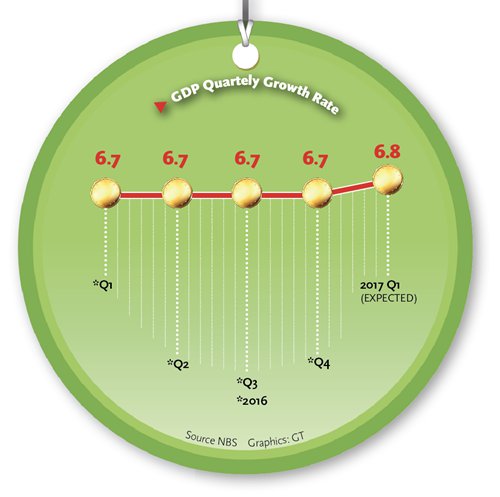
Graphics: GT
Hurdles remain, second half may be uphill battle: experts
First-quarter GDP growth in China was probably strong as its economy continued to stabilize, with a consensus forecast of 6.8 percent annual expansion from several research institutes, the Shanghai Securities News reported on Thursday.
Having booked a 6.8 percent growth in the last quarter of 2016, China will release key economic figures for the first quarter in mid-April. Full year GDP figure for 2016 was 6.7 percent.
On Wednesday, the National Academy of Economic Strategy (NAES), which is under the Chinese Academy of Social Sciences (CASS), estimated first-quarter growth at 6.8 percent, citing stronger production activity and investment. CASS is a Chinese government think tank.
The NAES report said that the firming trend in the fourth quarter of 2016 had continued into the first quarter of 2017.
It cited significant increases in wholesale prices, rebounding company profits and increasing imports.
The NAES estimated that China's economy would expand by 6.7 percent in the first half of this year, citing a likely moderate increase in industrial production and slightly slower growth in investment in the second quarter.
Several institutions have agreed with the NAES forecast.
On Tuesday, China Merchants Securities (CMS), in a research note sent to the Global Times, said it estimated that first-quarter GDP growth was 6.8 percent year-on-year. It cited an improved utilization rate at steel mills and coking companies, as well as stable growth in raw steel output and thermal coal consumption. A rebound in cement prices in North, East and Northeast China also helped.
The CMS report also mentioned that rebounding vehicle sales in February eased constraints on overall consumption.
In addition, the Bank of Communications, CITIC Securities and Shenwan Hongyuan Securities have estimated first-quarter GDP growth of 6.8 percent, according to the Shanghai Securities News report Thursday.
More optimistic estimates were issued by Southwest Securities, Guotai Junan Securities and Zheshang Securities. They put the figure at 6.9 percent, 7 percent and 7 percent, respectively, the Shanghai Securities News report said.
The Chinese government trimmed its 2017 growth target to around 6.5 percent, the lowest in one-quarter century.
Zhang Ning, a CASS research fellow, told the Global Times on Thursday that looking ahead to the second quarter, growth will likely fall a notch as matters such as a potential decrease in property development after local governments' curbed housing purchases will weigh on growth.
"Also, [China's] housing, monetary and fiscal policies will be gradually tightened, in tandem with the US Federal Reserve's interest rate hikes, and this too will weigh on growth," Zhang said.
The ongoing deleveraging that's intended to ease the debt burdens of some localities and enterprises will have its impact on the economy, according to Zhang.
Liu Xuezhi, a senior analyst at Bank of Communications, said these factors will further depress growth in the second half of the year. "Strong growth in investment was behind the strong figures for the first quarter, but the projected slowdown in growth in property development and [a continuation of] the slowing growth rate of consumption in January and February will confine the recovery to one that is in the short run, rather than a full-blown one. The third- and fourth-quarter figures may not be as good as that of the first quarter," Liu said.
Moody's Investors Service said Wednesday in a research note sent to the Global Times that China's economy faces heightened risks from a potential future property downturn, as about 25 percent to 30 percent of the country's economic activity is connected to final demand from the property and construction sectors.


















































